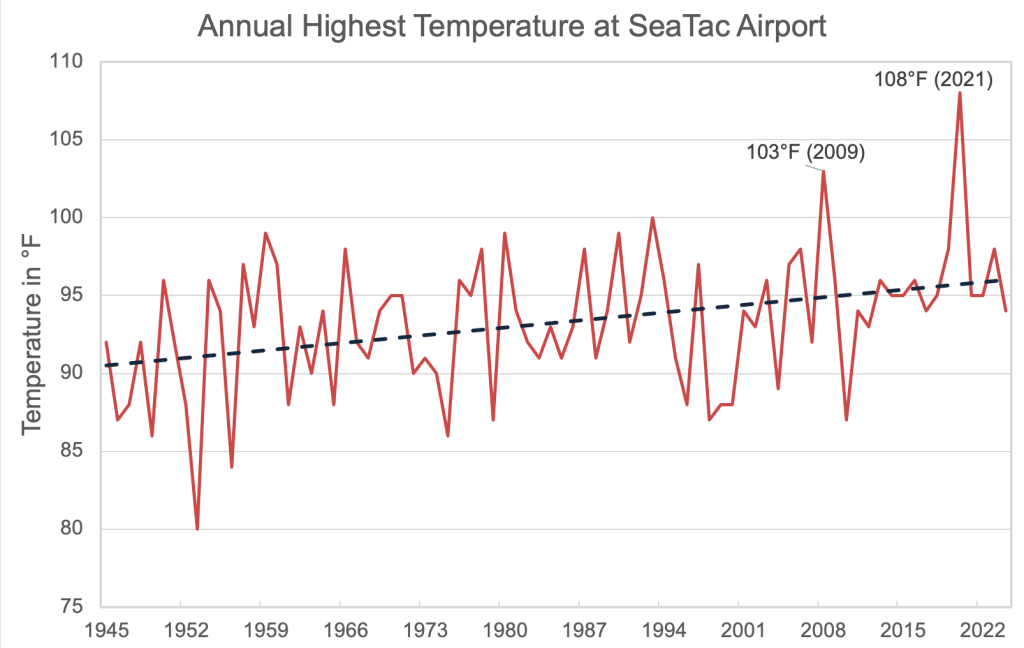Planning for Extreme Heat in Western Washington: Ongoing workshops highlight opportunities for regional collaboration and coordination
Summers in western Washington have historically been quite mild, but extreme heat has become much more common in the past couple of decades. In July of 2009, temperatures soared to 103°F in Seattle and some locations around Puget Sound rose to 100°F for the first time in recorded history. A mere decade later, during the heat wave of June 2021, temperatures rose to 108°F in Seattle and 116°F in Portland marking unprecedented summer record temperatures for both cities. This heat dome event broke high temperature records all across the state and set the all-time highest temperature in Washington state history of 120°F in Hanford, Washington. These recent events illustrate a troubling trend of increasing days of extreme heat in western Washington.

Looking into the future, climate models show that extreme heat events are likely to become two to seven times more frequent throughout the coming century. Recent heat events such as the 2021 heat wave have been impactful to human health, strain our energy and transportation infrastructure, stress marine ecosystems, and impact the economy. These recent events have spurred widespread discussion and action including state-level heat policy changes in Oregon and Washington and the development of an extreme heat warning system in British Columbia in direct response to this event.
Effectively preparing for heat risk requires sustained action and coordination. Knowledge and momentum are growing around this issue, with several organizations around the region working on adaptation solutions to proactively strengthen our regional capacity for preparing for and responding to heat in our communities.
This summer, the Washington State Climate Office (WASCO) participated in three separate extreme heat planning efforts, led by the National Oceanic and Atmospheric Administration (NOAA), the Tacoma-Pierce County Health Department, and the Center for Climate and Energy Solutions (C2ES). These separate efforts all aim to identify extreme heat risks, improve coordination and communication during events, and develop short and long-term policy and planning actions that would help minimize the impact of heat in our region. At these workshops, WASCO provided data on past and present heat trends and future heat projections to help planners understand the frequency with which extreme heat plans will need to be activated in the future.
Need data? Browse the CIG data repository or WASCO’s Data and Tools Library for access to various climate datasets and visualizer tools. If you would like assistance finding or interpreting data, please submit a data request.
The NOAA workshop brought together emergency managers, city and county officials, community organizations, and federal partners to scenario plan and coordinate the timeline of response to a mock heat wave event during a large outdoor event with international visitors, such as the World Cup. Issues such as language accessibility, unfamiliarity with local climate and emergency alerts systems, and ability to resource such a dense population were front and center.
The Tacoma-Pierce County Health Department’s workshop was focused on homebound individuals and the agencies and organizations who make sure resources and supportive care are maintained during heat events. Advanced warning, effective communication and messaging, and better sharing of resources during events were all identified as important opportunities for improvement.
The C2ES workshops brought a wide-range of sectors together to build relationships and identify key gaps in our resilience to heat events with the goal of developing clear action areas for regional extreme heat capacity building. During these workshops, participants identified key action areas including empowering community-led resource mobilization and collaborative governance, employing nature-based solutions such as urban greening and creating accessible green spaces, investing in grid improvements and small-scale decentralized backup power grids for community resilience. We discussed the interplay between land use, climate, and heat exposure, and actions that could bolster the resilience of local businesses during heat events.
As each participant shared stories about their personal experiences of extreme heat in their communities, it became clear that there are many opportunities to improve our ability to respond to these events.

Learning more about local vulnerabilities to heat, when colleagues activate their heat plan, and ongoing planning efforts for our future warmer climate helps foster a more unified response. Building relationships during these workshops proved to be invaluable, and this shared understanding is the bedrock of meaningful climate adaptation and resilience work.
These workshops highlighted not only the complexity of climate adaptation and resilience work, but also the abundance of opportunities for collective action. When we mobilize resources, communication, science-informed policy, and strong relationships across sectors to address extreme heat, what once seemed daunting starts to feel possible.
Related Resources
Global Warming Impacts in Washington State
In the Hot Seat: Saving Lives from Extreme Heat in Washington State